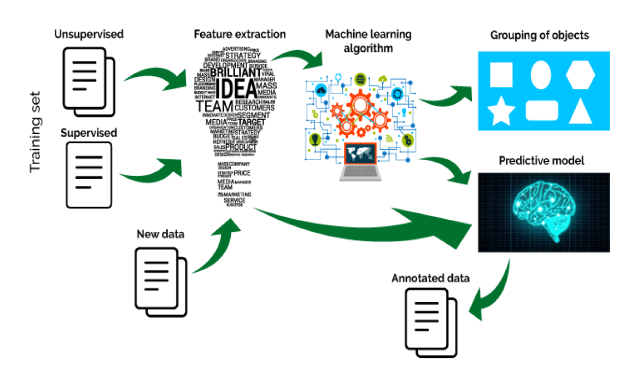Understanding Generative AI and Predictive Analytics
The emergence of artificial intelligence (AI) has had a profound effect on how businesses run and oversee daily activities. The introduction of numerous AI tools and applications has allowed organizations to make more informed decisions and automate tedious jobs, improving operations. Though there are many AI algorithms, Generative AI has become more popular across industries.
What is Generative AI?
Generative AI is a class of algorithms introduced by Merlin C. Wittrock in 1974 that can produce text, images, or audio from training data that appears to be original and authentic. A cue may be presented to generative AI in the form of text, an image, a video, a design, or a musical notation, which responds to the prompt by returning fresh content.
Chatbots first used generative AI in the 1960s, which was not well trained to produce convincingly authentic images, videos, or audio of real people until the invention of Generative Adversarial Networks (2014), a type of machine learning algorithm.
There are two parts to GAN: a generator and a discriminator. The generator is trained to create new images which resemble those in the training set. The discriminator is taught to differentiate between authentic pictures from the training collection and fake pictures created by the generator. This training procedure is called adversarial training.
Driving force behind Generative Learning Theory
The four main ideas of the generative learning theory are recall, integration, organization, and elaboration.
1. Recall: Used with fact-based information and pulling with long-term memory
2. Integration: Incorporating new concepts and facts with prior known facts and information with paraphrases
3. Organize: Relate the background knowledge to new concepts in a structured or meaningful manner by categorizing key ideas, similar topics, and concept maps.
4. Elaboration: Combining the new information with prior knowledge and synthesizing, adding ideas to the new concept.
Generative AI models
Generative AI also takes Transformers and Large Language Models into account. The large models are trained using transformers, a sort of machine learning, without needing to classify all of the data beforehand. Thus, new models are trained on trillions of pages of text, producing more in-depth responses.
Large language models (LLMs), or models with billions or even trillions of parameters, are capable of writing engrossing text, painting photorealistic visuals. They are able to produce images from text descriptions or captions automatically.
A specific neural network creates new content responding to a request or prompt. GANs and variational autoencoders (VAEs), which are neural networks with an encoder and decoder, are methods that are used to create realistic human faces, artificial data for AI training, or even facsimiles of specific persons.
Recent developments in transformers are Google’s Bidirectional Encoder Representations from Transformers (BERT), OpenAI’s GPT, and Google’s AlphaFold.
These generative models try to “prescribe and predict” forecasts based on the historical data where Predictive Analytics comes into the picture.
What is Predictive Analytics?
With the advancement of digital transformation, analytics professionals have numerous implementations of Generative AI for predictive analysis, collected from numerous sources as: Web, Industry 4.0, IoT devices, digital services, and transactions.
Predictive Analytics considers “What will happen next” through Predictive Modelling that anticipates conversion rates and “What’s the best that can happen?” through Optimization to enhance conversion rates.
An interconnection of both models works as below:

A generative pre-trained transformer (GPT) is improved using supervised learning and reinforcement learning.
The training data is supplied to the model for supervised learning; the trainers assume the user and AI helper roles. The trainers rank the model’s responses to a previous dialogue as the first stage of the reinforcement stage. With the use of several Proximal Policy Optimization iterations (PPO), which are cost-effective since they operate more swiftly while omitting several computationally expensive operations, these rankings are utilized to create “reward models” that are then further enhanced.
Additionally, it collects information from users that could be utilized to develop and improve the learning models. As in ChatGPT, users can upvote or downvote the results they get from ChatGPT and can add feedback in a text field that helps it train better.
Supervised learning
This resource-intensive strategy involves utilizing labeled datasets to train algorithms that can accurately categorize data or predict outcomes. The machines use well-labeled training data, which means that input data has previously been assigned the correct output, to predict the output. The dataset has three sections: a training dataset, a test dataset, and a validation dataset.
Supervised learning algorithms aim to learn a function by mapping feature vectors (inputs) to labels (outputs) based on example input-output pairs. The model is evaluated using test data (a subset of the training set) after the training phase gets completed, and it then generates output.”
Reinforcement learning
Reinforcement Learning is trained using the Human Feedback (RLHF) with a few modest adjustments to the data-gathering method. The supervised fine-tuning develops an initial model by using AI trainers to simulate both the user and the AI assistant in chats.
Conclusion
These models are increasingly used across various industry domains with use cases such as Increasing customer churn, customer segmentation, quality assurance, risk modeling, sentiment analysis, risk aggregation and reporting, cyber security, fraud detection, and determining the next best possible feasible and reliable move, and strategic planning.
Follow us on social media fo more updates on such topics.

